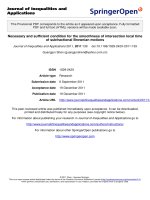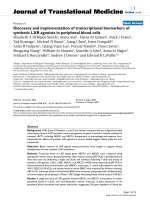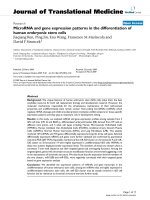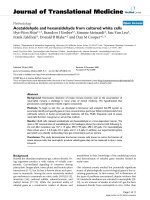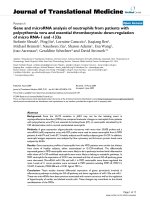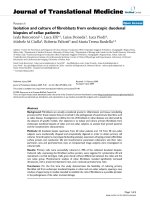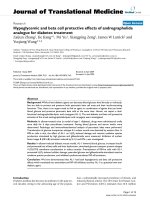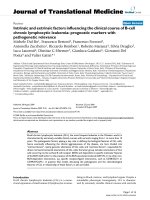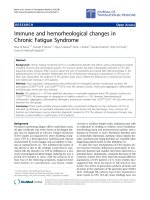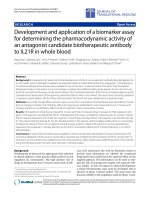báo cáo hóa học: " Fatness and fitness: how do they influence health-related quality of life in type 2 diabetes mellitus?" docx
Bạn đang xem bản rút gọn của tài liệu. Xem và tải ngay bản đầy đủ của tài liệu tại đây (259.54 KB, 7 trang )
BioMed Central
Page 1 of 7
(page number not for citation purposes)
Health and Quality of Life Outcomes
Open Access
Research
Fatness and fitness: how do they influence health-related quality of
life in type 2 diabetes mellitus?
Wendy L Bennett*
1
, Pamela Ouyang
2
, Albert W Wu
1,3
, Bethany B Barone
4
and Kerry J Stewart
2
Address:
1
Department of Medicine, Division of General Internal Medicine, Johns Hopkins University School of Medicine, Baltimore, MD, USA,
2
Department of Medicine, Division of Cardiology, Johns Hopkins University School of Medicine, Baltimore, MD, USA,
3
Department of Health
Policy and Management, Johns Hopkins Bloomberg School of Public Health, Baltimore, MD, USA and
4
Department of Epidemiology, Johns
Hopkins Bloomberg School of Public Health, Baltimore, MD, USA
Email: Wendy L Bennett* - ; Pamela Ouyang - ; Albert W Wu - ;
Bethany B Barone - ; Kerry J Stewart -
* Corresponding author
Abstract
Objective: We examined whether adiposity and fitness explain the decrease in health-related
quality of life (HRQOL) associated with type 2 diabetes mellitus.
Methods: This was a cross-sectional study using baseline data from two exercise training
interventions. One study enrolled people with and the other without type 2 diabetes. We assessed
aerobic fitness ("fitness") as peak oxygen uptake during treadmill testing, adiposity ("fatness") as
percentage of total body fat by dual-energy x-ray absorptiometry, and HRQOL by the Medical
Outcomes Study SF-36. Bivariate and multivariate linear regression analyses were used examine
determinants of HRQOL were used to examine determinants of HRQOL.
Results: There were 98 participants with and 119 participants without type 2 diabetes. Participants
with type 2 diabetes had a mean hemoglobin A1c of 6.6% and, compared with participants without
diabetes had lower HRQOL on the physical component summary score (P = 0.004), role-physical
(P = 0.035), vitality (P = 0.062) and general health (P < 0.001) scales after adjusting for age, sex and
race. These associations of HRQOL with type 2 diabetes were attenuated by higher fitness, even
more than reduced fatness. Only general health remained positively associated with type 2 diabetes
after accounting for fatness or fitness (P = 0.003). There were no significant differences between
participants with and without diabetes in the mental component score.
Conclusion: Improved fitness, even more than reduced fatness, attenuated the association of type
2 diabetes with HRQOL. The potential to improve HRQOL may motivate patients with type 2
diabetes to engage in physical activity aimed at increasing fitness. Findings from this cross-sectional
analysis will be addressed in the ongoing trial of exercise training in this cohort of participants with
type 2 diabetes.
Trial registration: NCT00212303
Published: 4 December 2008
Health and Quality of Life Outcomes 2008, 6:110 doi:10.1186/1477-7525-6-110
Received: 5 August 2008
Accepted: 4 December 2008
This article is available from: />© 2008 Bennett et al; licensee BioMed Central Ltd.
This is an Open Access article distributed under the terms of the Creative Commons Attribution License ( />),
which permits unrestricted use, distribution, and reproduction in any medium, provided the original work is properly cited.
Health and Quality of Life Outcomes 2008, 6:110 />Page 2 of 7
(page number not for citation purposes)
Background
Type 2 diabetes mellitus (type 2 diabetes) affects approxi-
mately 10% of the U.S. population aged 20 years and
older and its prevalence increases with age [1]. People
with type 2 diabetes report reduced health-related quality
of life (HRQOL) compared with the general population,
but higher than people with other chronic illnesses such
as congestive heart failure [2,3]. The presence of diabetes-
related complications, such as peripheral neuropathy, cor-
onary artery disease and peripheral vascular disease, are
known to reduce HRQOL [4,5]. Intensive medical treat-
ment regimens may be burdensome to patients and
reduce HRQOL [6], but may improve glycemic control
and increase net HRQOL [7-9].
Among people with type 2 diabetes, adiposity and
reduced fitness have adverse physiological effects that pro-
mote disease progression and increase cardiovascular dis-
ease mortality [10,11]. Increased adiposity is also an
important predictor of HRQOL among people with type 2
diabetes [12,13]. To our knowledge no study has exam-
ined the influence of adiposity and fitness on the associa-
tion of type 2 diabetes and HRQOL, using objective,
reproducible measures of adiposity and fitness to com-
pare people with and without diabetes. Based on prior
research [12-14], we hypothesized that reduced adiposity
and higher fitness levels would attenuate the association
of type 2 diabetes with HRQOL. We examined these asso-
ciations in baseline data from participants recruited for
two randomized controlled trials of exercise training for
hypertension. For this study we use the term "fatness" to
indicate total body adiposity, and "fitness" to indicate car-
diorespiratory fitness, which reflects both recent physical
activity and genetic makeup [15].
Methods
The Johns Hopkins Medicine Institutional Review Board
(Baltimore, MD) approved both studies. Informed written
consent was obtained from each participant. Participants
were recruited between 7/1/99 and 11/30/03 for the study
in people without type 2 diabetes and between 5/1/04
and 12/28/07 for the study in people with type 2 diabetes.
Study design and sample
This study was a cross-sectional analysis of baseline data
from participants recruited from the local urban and sub-
urban communities for two randomized controlled trials
to examine the effect of exercise training on blood pres-
sure. The two studies used similar testing protocols. Each
study used newspaper advertising for recruitment. Partici-
pants were provided with a cash incentive of $60 for the
baseline testing for the study in participants without dia-
betes and $50 for the study enrolling participants with
diabetes.
The first study enrolled people aged 55–75 years old with
untreated pre- or stage one hypertension (defined as
systolic blood pressure (BP) of 130–159 and/or diastolic
BP of 85–99 mm Hg). Subjects who were using only one
medicine for hypertension were allowed to discontinue
their medicine for 2-weeks prior to undergoing the screen-
ing for the study. People with a diagnosis of type 2 diabe-
tes were excluded from the first study.
The second study enrolled people aged 40–65 years old
with pre- or stage one hypertension (defined as systolic BP
of 130–159 and/or diastolic BP of 85–99 mm Hg) and
type 2 diabetes. Because subjects were recruited for an
exercise training trial, those with poor glycemic control
(fasting blood glucose > 400 mg/dl or HbA1C >11%) or
requiring insulin, were excluded. The participants with
type 2 diabetes using antihypertensive medications were
not discontinued from these medications for the exercise
trial, as it was felt that rigorous BP control was indicated
in those with a diagnosis of diabetes.
Participants in both studies were sedentary but free of self-
reported illnesses, such as chronic pain from orthopedic
conditions, peripheral arterial disease and cancer, that
could interfere with their full participation in a moderate-
intensity exercise program. Both studies excluded people
with electrocardiographic abnormalities indicative of
myocardial infarction or heart block, smoking and BMI ≥
40 kg/m
2
. An exercise stress test was used to identify and
exclude those with exercise-induced ischemic ST-T wave
changes (>1 mm), high-grade arrhythmias, or exercise-
induced cardiac symptoms.
Measures of aerobic fitness, fatness and HRQOL
The protocols for assessing fitness, fatness, and HRQOL
were identical in both studies. Fatness was reported as per-
centage of total body fat measured by dual energy x-ray
absorptiometry (DEXA) (GE Lunar Prodigy; General Elec-
tric Medical Systems, Milwaukee, Wis).
Aerobic fitness was assessed as the peak oxygen uptake
(VO
2
peak), determined on a graded exercise treadmill
using a SensorMedics Vmax 229 Metabolic System (Sen-
sorMedics Inc, Yorba Linda, Calif). The walking speed was
4.8 km/h at a grade of 0%, and the grade increased by
2.5% every 3 minutes to the point of volitional fatigue,
when participants indicated that they could walk no fur-
ther. Participants were encouraged to reach 18 or higher
on the Borg Rating of Perceived Exertion Scale [16].
HRQOL was assessed by the Medical Outcomes Study SF-
36 questionnaire [17,18], a self-administered 36-item
questionnaire that measures HRQOL using 8 scales: phys-
ical function, role limitations due to physical problems
(role-physical), role limitations due to emotional prob-
Health and Quality of Life Outcomes 2008, 6:110 />Page 3 of 7
(page number not for citation purposes)
lems (role-emotional), vitality, bodily pain, social func-
tion, mental health, and general health. Each scale is
scored separately from 0 (lowest level of function) to 100
(highest level of function). There are two calculated sum-
mary scales, the mental component score and the physical
component score. For summary scores, factor weights
derived from the U.S. general population were applied to
the eight SF-36 scales to compare with a mean of 50 and
standard deviation of 10 in the general population
[18,19]. The SF-36 has been validated extensively as a
measure of health status in people with chronic illness [2]
and other settings [20]. The SF-36 has good construct
validity, internal consistency and test-retest reliability in
racially diverse populations [18,21]. In this study the
mean Cronbach's alpha for the eight scales was 0.77
(range 0.71 to 0.83) which is comparable to other studies
using the SF-36 [2,20].
Data Analysis
We pooled baseline data from the two studies to yield a
total of 226 participants. Nine participants without a
complete SF-36 baseline questionnaire were excluded
from analyses. We assessed differences in HRQOL in par-
ticipants with and without type 2 diabetes using the stu-
dent's t-test. Because some of the SF-36 scales had
distributions that were positively skewed, we confirmed
these results using the Mann-Whitney test. We calculated
the Spearman correlation coefficient between fatness and
fitness. Multivariate linear regression was used to examine
the mean difference (represented by the beta coefficient
for "presence type 2 diabetes" variable) associated with
type 2 diabetes on each HRQOL scale, after adjusting for
age, sex and race, potentially confounding variables.
For each HRQOL scale with significant differences associ-
ated with type 2 diabetes in either adjusted or unadjusted
analyses, additional regression models were created to
examine the influence of fatness and fitness on the associ-
ation of type 2 diabetes with HRQOL. For each HRQOL
scale outcome, four models were created. First, we exam-
ined the association of type 2 diabetes with each HRQOL
scale after controlling for sociodemographics (age, sex
and race) in model 1. Model 2 added fatness to model 1
to assess its influence on the association of type 2 diabetes
with HRQOL. Model 3 added fitness to Model 1 to test its
influence on the type 2 diabetes-HRQOL association. The
final model (model 4) added both fatness and fitness to
model 1 to examine their combined effect. Interaction
terms between fatness and fitness in all final models
(model 4) were not statistically significant. Because some
of the SF-36 scales did not have normal distributions all
regression analyses were repeated using bootstrapping to
confirm the reported results. We scaled the partial regres-
sion coefficients by about one standard deviation to make
them interpretable and comparable across the four mod-
els. After scaling, changes in the HRQOL scales in the mul-
tivariate models are interpreted per 5 mL/kg·min increase
in VO
2
peak and per 10% increase in the percentage of
body fat.
Statistical analyses were performed using Stata version 9.2
(College Station, TX) [22].
Results
Characteristics of the study participants
In the combined baseline sample there were 217 partici-
pants, including 98 participants with and 119 participants
without type 2 diabetes. People with type 2 diabetes were
younger (p < 0.001), more likely to be male (p = 0.012)
and non-white (p < 0.001). Participants with type 2 dia-
betes had a mean hemoglobin A1c of 6.6% and a lower
mean total cholesterol than participants without type 2
diabetes (178.8 mg/dL vs. 215.2 mg/dL) (Table 1).
Participants without type 2 diabetes had a higher mean
percentage of body fat (38.2% vs. 36.0%) (Table 1). This
difference was explained by a higher percentage of females
without type 2 diabetes (53.7% vs. 37.3%), as women had
a higher percentage of body fat versus men (mean of 44%
vs. 32%, respectively). When stratified by sex there was no
significant difference in percent body fat between partici-
pants with and without type 2 diabetes. Participants with
type 2 diabetes also had lower levels of VO
2
peak despite
being younger (Table 1).
Fatness and fitness were negatively correlated, with the
Spearman r = -0.6241 (p < 0.001).
Comparison of HRQOL scales in participants with and
without type 2 diabetes
Participants with type 2 diabetes had lower mean scores
for general health (p < 0.001), vitality (p = 0.028) and the
physical component summary (p = 0.002) scales. The
mean SF-36 scales for bodily pain, physical function, role
emotional, role physical, social function, mental health
and mental component score were all lower in people
with type 2 diabetes but the differences did not reach sta-
tistical significance (Table 1).
For each HRQOL scale, we assessed the mean difference in
HRQOL associated with the presence of type 2 diabetes,
after adjusting for age, sex and race (Table 2). Type 2 dia-
betes was associated with a 12-point decrease in general
health (P< 0.001), 8-point decrease in role limitations due
to physical problems (P = 0.035), 5-point decrease in
vitality and almost a 3-point decrease in the physical com-
ponent score (Table 2).
Health and Quality of Life Outcomes 2008, 6:110 />Page 4 of 7
(page number not for citation purposes)
Influence of fatness and fitness on the differences in
HRQOL associated with type 2 diabetes
We assessed the influence of fatness and fitness individu-
ally and then together on the differences in HRQOL asso-
ciated with type 2 diabetes in the general health, role
physical and vitality scales, and the physical component
score. These scales had significant differences associated
with type 2 diabetes in either unadjusted analyses or anal-
yses adjusted for age, sex and race.
For general health, the addition of fatness to model 1 did
not greatly influence the decrement in HRQOL associated
with type 2 diabetes (mean difference of -12.87, P =
0.001). Fitness influenced the association of general
health with type 2 diabetes (models 3 and 4), but type 2
diabetes remained highly significant [Additional file 1].
An improvement in fitness by 5 mL/kg·min of VO
2
peak
was associated with a 4-point increase in general health in
the final model [Additional file 1].
Type 2 diabetes was associated with an 8-point decrease in
the role-physical scale after adjusting for sociodemo-
graphic characteristics and fatness (P = 0.035, model 2).
The negative association of type 2 diabetes with the role-
physical scale was attenuated, becoming non-significant,
with the addition of fitness in models 3 and 4 [Additional
file 1].
The addition of fitness in models 3 and 4 attenuated the
association of type 2 diabetes and vitality. An improve-
Table 1: Characteristics of and health-related quality of life in participants with and without type 2 diabetes
Characteristic No type 2 Diabetes
N = 119
With type 2 Diabetes
N = 98
P value
Mean age (SD), years 63.8 (5.6) 56.9 (5.9) < 0.001
Men, % 46.2 63.3 0.012
White race, % 85.7 60.2 < 0.001
Mean percentage of body fat (SD), % 38.2 (9.2) 36.0 (7.1) 0.068
Mean VO
2
peak (SD), mL/kg·min 24.1 (5.1) 21.2 (5.1) < 0.001
Mean total cholesterol level (SD), mg/dL 215.2 (37.5) 178.8 (40.2) < 0.001
Mean hemoglobin A1c (SD), % N/A 6.6 (1.5) N/A
SF-36 HRQOL Scale Mean (SD) Mean (SD) P value
Bodily pain 78.0 (17.9) 74 (16.4) 0.130
General health 80.3 (14.1) 65.7 (17.0) < 0.001
Mental health 84.3 (11.7) 82.0 (14.2) 0.189
Physical function 86.4 (13.5) 85.6 (14.2) 0.656
Role emotional 87.7 (24.5) 84.7 (28.8) 0.411
Role physical 89.3 (20.0) 82.8 (29.1) 0.055
Social function 93.3 (12.9) 89.3 (18.8) 0.066
Vitality 68.8 (16.1) 63.5 (19.5) 0.028
Physical component score 51.1 (5.6) 48.4 (6.9) 0.002
Mental component score 54.8 (6.9) 53.3 (8.8) 0.156
Abbreviations: SD = standard deviation; HRQOL = health-related quality of life; kg = kilogram; m = meter; mL = millileter; min = minute.
Table 2: Adjusted* mean differences in SF-36 HRQOL scales associated with type 2 diabetes
SF-36 HRQOL Scale Adjusted* mean differences associated with type 2 diabetes P value
Bodily pain -5.28 0.065
General health -12.84 < 0.001
Mental health -1.84 0.388
Physical function -1.28 0.572
Role emotional -4.86 0.259
Role physical -8.61 0.035
Social function -2.83 0.282
Vitality -5.48 0.062
Physical component score -2.99 0.004
Mental component score -1.33 0.300
Abbreviations: HRQOL = health-related quality of life;
* Adjusted for age, sex and race.
Health and Quality of Life Outcomes 2008, 6:110 />Page 5 of 7
(page number not for citation purposes)
ment in fitness by 5 mL/kg·min of VO
2
peak was associ-
ated with a 4-point increase in vitality in model 4
[Additional file 1].
The association of type 2 diabetes with the physical com-
ponent score was augmented with the addition of fatness
in mode1 2 (mean difference of -3.25, P = 0.002). A 10%
increase in the percentage of body fat was associated with
a 2-point decrease in the physical component score
(model 2). However, the negative association between
type 2 diabetes and the physical component score was
attenuated, becoming non-significant, with the addition
of fitness in models 3 and 4 [Additional file 1].
Discussion
There are several important new findings in this cross-sec-
tional study examining the influence of fatness and fitness
on the association of type 2 diabetes with HRQOL in par-
ticipants with and without type 2 diabetes. First, we con-
firmed the negative impact on the physical aspects of
HRQOL in type 2 diabetes, which was concentrated in the
scales measuring role limitations due to physical prob-
lems (role-physical), vitality, general health, and the phys-
ical component summary score. No significant reductions
were found in self-reported mental health in our partici-
pants, who on-average, had well-controlled type 2 diabe-
tes. Second, a new finding from this study was that higher
levels of fitness, more so than lower fatness, attenuated
much of the association of HRQOL with type 2 diabetes
in most of these physical health domains. However, nei-
ther fatness nor fitness ameliorated the strong negative
association of type 2 diabetes with the general health
scale. This seems reasonable, since the presence of a dia-
betes diagnosis in and of itself would be expected to influ-
ence a patient's self perceived health.
Few studies have examined the association of fatness and
fitness on HRQOL in people with type 2 diabetes. In the
Look Ahead Study, both lower fitness and obesity were
associated with lower physical component summary
scores in people with type 2 diabetes [13], a finding con-
sistent with our study. In our study fatness and fitness are
associated with each of the eight SF-36 scales. We provide
insight about how fatness and fitness may affect general,
mental and physical health individually. This was espe-
cially informative in identifying a significant association
of type 2 diabetes with general health, even after adjusting
for fatness and fitness. It is notable that we found no sig-
nificant association between type 2 diabetes and reduced
mental health, despite studies showing an increase in the
prevalence of depression among people with type 2 diabe-
tes [23]. This may reflect that the present participants vol-
unteered for an exercise program, suggesting an interest in
improving their health, and had well-controlled diabetes,
thus less likely to be experiencing symptoms and disease
complications that might impact their mental health.
There are limitations to our study. First, because the par-
ticipants were volunteers for exercise training studies and
had well-controlled type 2 diabetes, they were, by defini-
tion, less likely to have diabetes-related complications
and co-morbid illnesses. Nevertheless, unmeasured less
severe co-morbidities such as arthritis and use of medica-
tions may be different between the two studies, which
could be confounders. Importantly, prior studies have
found that disease complications are the strongest deter-
minants of quality of life in people with type 2 diabetes
[3]. However, the studies' exclusion criteria make it more
likely that the two groups were otherwise similar with
respect to health status, except for their diabetes diagnosis.
A second limitation is that the two combined studies used
slightly different selection criteria for age (55–75 years in
the study without diabetes and 40–65 years in the study
with diabetes) making age a potential confounder. To
address this limitation, we performed a sensitivity analysis
in the sample with overlapping ages (N = 143) and con-
firmed the overall results. A third limitation is that the two
combined study populations differed with respect to the
use of antihypertensive therapy, which may also be a con-
founder. Both populations had the diagnosis of pre- or
stage 1 hypertension, but those without diabetes were
untreated according to the study protocol; whereas, those
with diabetes were continued on the antihypertensive
medications prescribed by their own health care provid-
ers. This is unlikely to influence our results, as both groups
do meet criteria for pre- or stage 1 hypertension, and com-
pared with other chronic diseases, hypertension has been
shown to have the lowest impact on quality of life [2]. A
fourth limitation was the use of the SF-36, a general not
diabetes-specific, HRQOL instrument. It may have been
less responsive to diabetes-specific symptoms and aspects
of life [24,25]. The SF-36 was used as it is both reliable
and valid in these populations, and allowed for compari-
sons between groups with and without type 2 diabetes.
However, many studies of HRQOL in people with type 2
diabetes are now including both a diabetes-specific and a
general measure of HRQOL [12,26]. Finally, the sample
size of 217 may have reduced our power to detect differ-
ences in HRQOL, especially in the area of mental health,
where the differences were not statistically significant.
There are several notable strengths to our study. The selec-
tion criteria enabled us to recruit people with less-compli-
cated type 2 diabetes, who may represent a large number
of patients, such as those with new diagnoses and not
requiring insulin. These patients may also be more physi-
cally able, as well as motivated to engage in lifestyle
changes. Despite having well-controlled disease, we did
detect significant HRQOL detriments as compared to the
Health and Quality of Life Outcomes 2008, 6:110 />Page 6 of 7
(page number not for citation purposes)
participants without type 2 diabetes. Another study
strength was the use of two reproducible and precise
measures of fatness and fitness, namely the percentage of
body fat obtained from DEXA and the VO
2
peak obtained
from treadmill testing. Other studies, including the Look
Ahead study used estimated MET capacity, as the fitness
measure, and body mass index, a crude measure of total
adiposity [13].
This study has several public health and clinical implica-
tions. It is well-established that successful adoption of
health behaviors focused on diet and exercise leading to
weight loss and increased fitness improve clinical out-
comes in people with type 2 diabetes [27,28]. These
results suggest that higher levels of fitness might also
enhance HRQOL. This is especially important because
studies show that lower HRQOL is independently associ-
ated with both cardiovascular events [29] and higher mor-
tality in people with type 2 diabetes [30]. Providers may
be motivated to more frequently assess HRQOL. In addi-
tion, providers might counsel patients with type 2 diabe-
tes that incorporating physical activity into their daily
routine improves fitness, allows them to do more, feel
better, as well as reduce their risk of cardiovascular disease
and diabetes-related complications.
Further studies are needed to confirm our findings from
this cross-sectional study. There have been few studies
examining the effect of a lifestyle intervention, such as
exercise, on HRQOL in people with type 2 diabetes [31].
We anticipate having results in late 2009 for the exercise
training trial in participants with type 2 diabetes to be able
assess whether exercise leading to improved fitness levels
improves HRQOL, as our cross-sectional results suggest.
Future studies could examine the effects of fatness and fit-
ness in a population with a wider range of diabetes sever-
ity, treatment types and co-morbid illness, in order to
control for the multitude of factors that impact HRQOL.
In addition, it would be helpful to explore the presence of
depressive symptoms and use both general and diabetes-
specific instruments to better understand the relation-
ships between fitness, fatness and HRQOL in type 2 dia-
betes.
Conclusion
Uncomplicated type 2 diabetes is associated with lower
HRQOL. Improved fitness, even more than reduced fat-
ness, was associated with improved HRQOL in people
with type 2 diabetes. Ongoing research is addressing
whether or not increased fitness levels improve HRQOL.
Further investigation is needed to assess the role of fitness
and fatness on HRQOL in populations with a wider range
of diabetes-related complications and co-morbid ill-
nesses.
Abbreviations
BP: blood pressure; DEXA: dual-energy x-ray absorptiom-
etry; Fatness: adiposity; Fitness: aerobic fitness; HgBA1c:
hemoglobin A1c; HRQOL: health-related quality of life;
kg: kilogram; m: meter; mL: millileter; min: minute; SD:
standard deviation; Type 2 diabetes: type 2 diabetes mel-
litus; T2DM: type 2 diabetes mellitus; VO
2
peak: peak oxy-
gen uptake determined at volitional fatigue during
treadmill testing.
Competing interests
The authors declare that they have no competing interests.
Authors' contributions
WB contributed to the development of the research ques-
tion, study planning, data analysis and drafting and revis-
ing the manuscript. PO contributed to the study design,
development of the research question and revising the
manuscript and has given final approval for the version to
be published. AW contributed to the development of the
analytic plan and editing the manuscript has given final
approval for the version to be published. BB contributed
to the development of the analytic plan and editing the
manuscript and has given final approval for the version to
be published. KS was the principal investigator for the two
trials that this study is based on, and as such, contributed
to study design, data collection, development of the
research question, study planning and manuscript edit-
ing. He has given final approval for the version to be pub-
lished.
Additional material
Acknowledgements
This publication was made possible by Grant Number UL1 RR 025005 from
the National Center for Research Resources (NCRR), a component of the
National Institutes of Health (NIH), and NIH Roadmap for Medical
Research. Its contents are solely the responsibility of the authors and do
not necessarily represent the official view of NCRR or NIH. Information on
NCRR is available at />. Information on Re-engineer-
ing the Clinical Research Enterprise can be obtained from http://nihroad
map.nih.gov/clinicalresearch/overview-translational.asp.
The authors acknowledge Dr. Nae-Yuh Wang for statistical consultation.
Additional file 1
Table 3. Influence of fatness and fitness on the association of type 2 dia-
betes with health-related quality of life. The data represent the multivari-
ate regression models for four HRQOL outcomes to examine the influence
of fatness and fitness on the association of type 2 diabetes with HRQOL.
Click here for file
[ />7525-6-110-S1.doc]
Publish with Bio Med Central and every
scientist can read your work free of charge
"BioMed Central will be the most significant development for
disseminating the results of biomedical research in our lifetime."
Sir Paul Nurse, Cancer Research UK
Your research papers will be:
available free of charge to the entire biomedical community
peer reviewed and published immediately upon acceptance
cited in PubMed and archived on PubMed Central
yours — you keep the copyright
Submit your manuscript here:
/>BioMedcentral
Health and Quality of Life Outcomes 2008, 6:110 />Page 7 of 7
(page number not for citation purposes)
References
1. National Institute of Diabetes and Digestive and Kidney Diseases:
National Diabetes Statistics fact sheet: General information
and national estimates on diabetes in the United States.
2005.
2. Stewart AL, Greenfield S, Hays RD, Wells K, Rogers WH, Berry SD,
McGlynn EA, Ware JE Jr: Functional status and well-being of
patients with chronic conditions. Results from the Medical
Outcomes Study. JAMA 1989, 262(7):907-13.
3. Rubin RR, Peyrot M: Quality of life and diabetes. Diabetes Metab
Res Rev 1999, 15(3):205-18.
4. Glasgow RE, Ruggiero L, Eakin EG, Dryfoos J, Chobanian L: Quality
of life and associated characteristics in a large national sam-
ple of adults with diabetes. Diabetes Care 1997, 20(4):562-7.
5. Wandell PE: Quality of life of patients with diabetes mellitus.
An overview of research in primary health care in the Nordic
countries. Scand J Prim Health Care 2005, 23(2):68-74.
6. Jacobson AM, de Groot M, Samson JA: The evaluation of two
measures of quality of life in patients with type I and type II
diabetes. Diabetes Care 1994, 17(4):267-74.
7. Menard J, Payette H, Dubuc N, Baillargeon JP, Maheux P, Ardilouze JL:
Quality of life in type 2 diabetes patients under intensive
multitherapy. Diabetes Metab 2007, 33(1):54-60.
8. Quality of life in type 2 diabetic patients is affected by com-
plications but not by intensive policies to improve blood glu-
cose or blood pressure control (UKPDS 37). U.K.
Prospective Diabetes Study Group. Diabetes Care 1999,
22(7):1125-36.
9. Jacobson AM: Impact of improved glycemic control on quality
of life in patients with diabetes. Endocr Pract 2004, 10(6):502-8.
10. Wei M, Gibbons LW, Kampert JB, Nichaman MZ, Blair SN: Low car-
diorespiratory fitness and physical inactivity as predictors of
mortality in men with type 2 diabetes. Ann Intern Med 2000,
132(8):605-11.
11. Church TS, LaMonte MJ, Barlow CE, Blair SN: Cardiorespiratory
fitness and body mass index as predictors of cardiovascular
disease mortality among men with diabetes. Arch Intern Med
2005, 165(18):2114-20.
12. Sundaram M, Kavookjian J, Patrick JH, Miller LA, Madhavan SS, Scott
VG: Quality of life, health status and clinical outcomes in
Type 2 diabetes patients. Qual Life Res 2007, 16(2):165-77.
13. Rejeski WJ, Lang W, Neiberg RH, Van Dorsten B, Foster GD, Macie-
jewski ML, Rubin R, Williamson DF, Look AHEAD Research Group:
Correlates of health-related quality of life in overweight and
obese adults with type 2 diabetes. Obesity (Silver Spring) 2006,
14(5):870-83.
14. Stewart KJ, Turner KL, Bacher AC, DeRegis JR, Sung J, Tayback M,
Ouyang P: Are fitness, activity, and fatness associated with
health-related quality of life and mood in older persons? J
Cardiopulm Rehabil 2003, 23(2):115-21.
15. Haskell WL, Leon AS, Caspersen CJ, Froelicher VF, Hagberg JM, Har-
lan W, Holloszy JO, Regensteiner JG, Thompson PD, Washburn RA,
et al.: Cardiovascular benefits and assessment of physical
activity and physical fitness in adults. Med Sci Sports Exerc 1992,
24(6 Suppl):S201-20.
16. Borg G: Measuring Perceived Exertion and Pain. In Borg's Per-
ceived Exertion and Pain Scales Human Kinetics; 1998.
17. Stewart AL, Ware JE Jr: Measuring Functioning and Well-being:
The Medical Outcomes Study Approach. Durham, NC: Duke
University Press; 1992.
18. Ware JE Jr, Snow KK, Kosinski M: SF-36 Health Survey: Manual
and Interpretation. Boston, MA: The Health Institute, New Eng-
land Medical Center; 1993.
19. Ware JE, Kosinski M: SF-36 physical & mental health summary
scales: A manual for users of version 1. 2nd edition. Lincoln, RI:
QualityMetric; 2001.
20. Brazier JE, Harper R, Jones NM, O'Cathain A, Thomas KJ, Usherwood
T, Westlake L: Validating the SF-36 health survey question-
naire: new outcome measure for primary care. BMJ 1992,
305(6846):160-4.
21. McHorney CA, Ware JE Jr, Lu JF, Sherbourne CD: The MOS 36-
item Short-Form Health Survey (SF-36): III. Tests of data
quality, scaling assumptions, and reliability across diverse
patient groups. Med Care 1994, 32(1):40-66.
22. StataCorp: Stata Statistical Software. Release 9 2005.
23. Anderson RJ, Freedland KE, Clouse RE, Lustman PJ: The prevalence
of comorbid depression in adults with diabetes: a meta-anal-
ysis. Diabetes Care 2001, 24(6):1069-78.
24. Polonsky WH, Fisher L, Earles J, Dudl RJ, Lees J, Mullan J, Jackson RA:
Assessing psychosocial distress in diabetes: development of
the diabetes distress scale. Diabetes Care 2005, 28(3):626-31.
25. El Achhab Y, Nejjari C, Chikri M, Lyoussi B: Disease-specific
health-related quality of life instruments among adults dia-
betic: A systematic review. Diabetes Res Clin Pract 2008.
26. Huang IC, Hwang CC, Wu MY, Lin W, Leite W, Wu AW: Diabetes-
specific or generic measures for health-related quality of life?
evidence from psychometric validation of the D-39 and SF-
36. Value Health 2008, 11(3):450-461.
27. Sigal RJ, Kenny GP, Boule NG, Wells GA, Prud'homme D, Fortier M,
et al.: Effects of aerobic training, resistance training, or both
on glycemic control in type 2 diabetes: a randomized trial.
Ann Intern Med 2007, 147(6):357-69.
28. Hamdy O, Goodyear LJ, Horton ES: Diet and exercise in type 2
diabetes mellitus. Endocrinol Metab Clin North Am 2001,
30(4):883-907.
29. Hayes AJ, Clarke PM, Glasziou PG, Simes RJ, Drury PL, Keech AC:
Can self-rated health scores be used for risk prediction in
patients with type 2 diabetes? Diabetes Care 2008,
31(4):795-797.
30. Kleefstra N, Landman GW, Houweling ST, Ubink-Veltmaat LJ,
Logtenberg SJJ, Meyboom-DeJong B, Coyne JC, Groenier KH, Bilo
HJG: Prediction of mortality in type 2 diabetes from health-
related quality of life (ZODIAC-4). Diabetes Care 2008,
31(5):932-933.
31. Zhang X, Norris SL, Chowdhury FM, Gregg EW, Zhang P: The
effects of interventions on health-related quality of life
among persons with diabetes: a systematic review. Med Care
2007, 45(9):820-34.
